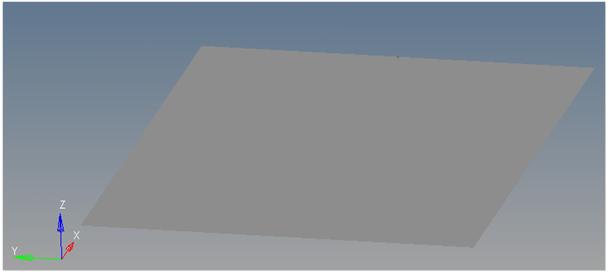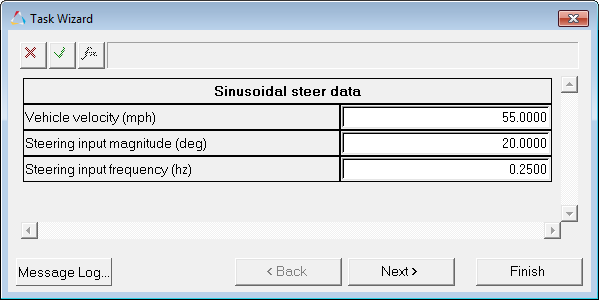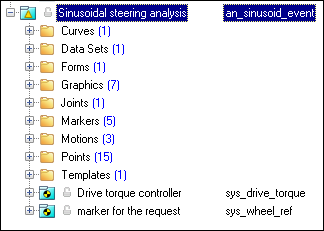Sinusoidal Steering |

|

|

|

|
|
Sinusoidal Steering |

|

|

|

|
A Sinusoidal steering event simulates a vehicle driving at a constant speed while a sin wave input is applied to the steering wheel. The event is used to simulate the On-center steering test described in SAE paper 840069. Standard vehicle outputs are included in the event. Body state variable output requests (displacement, velocity, acceleration) are included in the body system and tire output is included in the Tire System. A plot template is available to plot the results.

Sinusoidal Steering Event

Top View of a Sinusoidal Steering (Vehicle is Extremely Small)
The Sinusoidal steering event is designed to work with a full vehicle model that has been built through the MotionView Assembly Wizard. The event should attach to the model automatically when added through the Task Wizard. The event can be used with models built manually, as long as the attachment scheme in the event is strictly followed.
The event is conducted to determine the vehicle response to the steering wheel input from a low frequency sin wave. The event simulates the performance of the vehicle in the under a 0.2G lateral event and is used to characterize the steering feel for driving events where the vehicle needs to be precisely controlled. The event should predict steering feel for the vehicle in normal highway events at moderate lateral acceleration (under 0.3G).
The values for the initial Vehicle velocity, Steering input magnitude, and Steering input frequency can be modified via the event Form (shown below).

Sinusoidal Steering Data Dialog
The entities in the event are displayed in the MotionView Project Browser as shown in the image below:

Project Browser View - Forms - Sinusoidal Steering Analysis
Nine types of modeling element containers (Datasets->templates) are used to define the event (see below). Two sub-systems (a Drive torque controller and a marker for the request) are also included in the event.
The event uses the standard event attachment. The attachments resolve automatically if the model is built through the Model Wizard. The attachments contain the minimum data the event needs to run the analysis. The attachments are standard for most events.
Sinusoidal Steering Event – Attachments |
A single curve is included in the Sinusoidal steering event. The curve is not used by the event but is included in case you want to switch to an event that is driven on a path.
Project Browser View - Curves - Sinusoidal Steering Analysis |
One dataset is used in the system, which contains the data used to describe the Sinusoidal steering event. The event allows you to set the initial vehicle velocity, lane width, steering input magnitude and steering input frequency. The wheel rotational velocities and ground height (shown with a blue background) are calculated values and should not be changed.
Project Browser View - Datasets - Sinusoidal Steering Analysis
Dataset Property Data Dialog - Sinusoidal Steering Analysis |
The Form is the only place that you should change the Sinusoidal steering event. Vehicle velocity, Steering input magnitude and Steering input frequency are the parameters that can be modified. You can edit the event template if you want to make the event run longer.
Project Browser View - Forms - Sinusoidal Steering Analysis
Sinusoidal Steer Data Analysis - Form Dialog |
Seven graphics are defined in the event. The graphics define the cones and the straight road graphics and should not require any user input. The straight road graphics are included to illustrate the path being driven and are defined parametrically using the data in the Sinusoidal steering Form. Straight road graphics should never require editing unless the event is being fundamentally changed.
Project Browser View - Graphics - Sinusoidal Steering Analysis
Cone Graphics
Straight Road Graphics |
A ball joint is included in the Sinusoidal steering event. The joint attaches a dummy body to the steering rack. The joint is included to make certain events work in ADAMS. Attach the dummy body to the steering rack if building a model manually.
Project Browser View - Joints - Sinusoidal Steering Analysis
Joints Panel - Sinusoidal Steering Analysis |
Five markers are included in the Sinusoidal steering event. The path origin is the origin of all graphics and is parametrically defined to be the CG of the vehicle body. The markers refer to points and the points contain the parametric logic. The path outline markers point to the path outline points for their XYZ location. The markers are used to define the road graphics. None of the markers should require any user input.
Project Browser View - Markers - Sinusoidal Steering Analysis |
Three motions are included in the event. The steering motion is used to steer the vehicle and acts on a revolute joint that connects the steering column to the vehicle body. If a steering column is not included in the model, the motion acts on a joint between the steering rack input shaft and the vehicle body. The Front and Rear Wheel Motions act on the wheel spindle revolute joints connecting the wheel hub to the knuckle. The motion is initially zero (fixing the wheels to the knuckle) so the model converges statically. After static analysis, the wheel locking motions are deactivated to allow the tires to rotate during the dynamic analysis.
Project Browser View - Motions - Sinusoidal Steering Analysis |
Fifteen points are defined in the Sinusoidal steering event. All points are used to create the road graphics and cone graphics used to illustrate the road. The points contain parametric logic to define their X, Y, and Z locations. You should not need to modify any points.
Project Browser View - Points - Sinusoidal Steering Analysis |
A template is included in the Sinusoidal steering event task. The template is solver specific, and only the MotionSolve template is documented. The template is inserted in the solver deck after the </Model> command and controls the execution of the event. The steering wheel motion is modified in the template to use the values found in the dataset. The event end time (default is 6 seconds) is set in the template and should be modified to simulate a complete on-center steering test.
Project Browser View - Templates - Sinusoidal Steering Analysis The template for this event is shown below:
|
SAE 840069 – Objective Evaluation of On-Center Handling Performance.